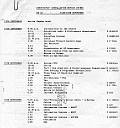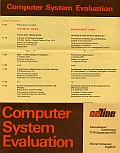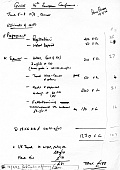| |
- The
NCB Benchmark
go to 'NCBC'
- Birmingham
(Midlands) Systems Centre The operation of large computer
complexes. Performance .
go to 'FSC'
- World
Trade task force on SE Aids and Tools Requirements 1970
go to 'WT Tools'
- Performance
Tools go to using 'Performance Tools'
-
Major Studies - Measurment & Tuning Specialist
go to 'Major Studies'
- Papers/Talks
go to 'Papers & Talks'
-
UK IBM Rep to GUIDE User Group go to 'Guide'
- Other
/ Symposiums Lisbon / MBCS
Missed
assignment
- 1974: Move
to IBM UK Information Systems, Cosham
go to 'UKIS'
- 'Advanced
Systems Development', IS Strategy, CICS, IMS
- Early
'Online Services' The operation of T/P Services (the
first 'help-desks')
- Early
'Text Systems' / Stairs text retrieval / ATMS text processing.
-
The first moves towards 'paperless office'. The 'CREATION'
Project / IBM North Harbour opening
- The
first 'Office Systems' - PSS, PROFS, Email, shared diaries
- Colour
Terminals
|
see
also:
IBMMemories1960s.htm
IBMMemories1980s.htm
IBMMemories1990s.htm
index.htm
- Main IBM Memories Page
|
| |
|
|
| NCB |
The NCB Benchmark
The
National Coal Board was a massive organisation, with a considerable
number of administrative centres (and hence computer installations).
They had large numbers of mainframes, basically from ICL
and IBM. In about 1970 they were planning a major upgrade
and decided to run a competitive benchmark between IBM and
ICL. They compiled a tape with several hours of typical
work (eg Cobol programs). On an appointed day each manufacturer
was to run the benchmark on one of their systems amongst
those already installed at NCB. There was a coin toss and
as a result IBM were to run a day after ICL.
So we set to and got the suite
running on a 360/50 at NCB Cannock. The day came and the
'selection committee' took their places on a row of chairs
in the computer centre, said "Go" and started their stop-watches.
We used the HASP spooling program
to help speed up the run. But our secret weapon was the
IBMer choosen to operate the system for the run. He was
a very capable and a very, very, err, 'large' guy.
As the run proceeded we thought
we could see the members of the committee that were noting
the times taken for the various segments were looking impressed.
Things were roaring through and the operator was clearly
having to rush like mad to keep the system fed with cards,
tapes and paper. I think the rules said that the committee
weren't allowed to tell us the actual results, that was
saved for a final assessment.
But, privately, one of the committee
said 'there was a clear winner - apart from any timings,
before that day none of the committee had ever seen
a computer operator SWEAT'
|
|
| FSC |
Midland
Region Systems Centre, Birmingham
360
Usage, also the first 370s, MVS, VM,
-
Specialised in Systems Performance.
-
Assessed and reported to customer management in many
large UK accounts
- Involved
in the introduction and marketing of VS to branches
and in many sales and support situations
- Marketing
and support to many customers/prospects in Midlands
and elsewhere
-
-
|
Systems Centre Staff 7/71 & 3/73 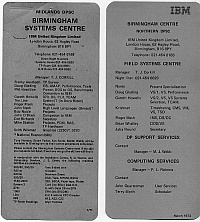 Click for bigger picture..
Click for bigger picture..
|
| Tools Task Force |
World Trade task force on SE Aids and Tools Requirements
In 1970 I went to IBM Poughkeepsie in New York State for
3 or 4 weeks. There were quite a number of useful 'Apps'
being passed around on the grapevine. A few SEs from various
countries(UK, Germany, France, Canada) were brought together
to try and sort out which were the most beneficial and
work out how to best organise the distribution of them.
(this lead up to creation of 'HONE Aids' centres).
At
the weekends we had some time to amuse ourselves. So on
the first free weekend I decided to drive down to Manhattan
and look around there. The hire car I had was playing
up a bit, so I thought I would drive down, turn it in
and collect a different one on Sunday to drive back. But...
when I went to get a new car, it turned out that my Driving
Licence' had expired. So no car - I had to get a train
up to Poughkeepsie (it's a nice journey incidentally,
along the shores of the Hudson).
I was then stuck for the rest of the trip with no car.
I could walk to the World Trade Systems Centre, but going
out to eat in the evening was a problem. There was a guy
from IBM Germany staying at the same motel (the Edison?)
who I went out to eat with a few times, but he would only
go to very germanic places and in fact didn't speak that
much English either.
The second weekend I had a bright
idea on what to do without a car - catch a train. Up to
Niagara Falls (which I'd never seen). So train to Buffalo
and shared minibus onwards to Niagara. Found a hotel (on
the US side) and next day went exploring. Thought I'd
go onto the US-Canada road bridge which looked a good
spot to take some photos. To get on the bridge you just
walk through a turnstile.
After a while I turned to go back off the bridge - and
ran into an immigration booth. A big problem emerged -
I'd left my passport at the hotel - they wouldn't let
me in. Even my IBM badge didn't help! So what I had to
do was go all the way acrosss the bridge to Canadian immigration,
and get them to issue me with a formal notice saying I'd
been refused entry into Canada. With that I eventually
got back into the USA.....
|
|
| Performance Tools |
Tools
During
the late 60s and early 70s I did a lot of work on the
performance of large computer systems. There were three
main tools:
- Advanced
Multiprogramming Analysis Procedure (AMAP)
- The
Generalized Trace Facility (GTF)
- ABCTIMER
- by one A.B.Cleaver. (This was actually written 1966/67
- I have the source program listing of this tool - must
be a fairly rare document!)
These
usually produced voluminous 'trace' data - the trick was
in analysing this and making sense of what was causing problems.
|
ABCTimer Assembler Listing pg 1
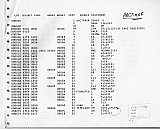 Click for bigger picture..
Click for bigger picture..
|
| Major Studies |
Major Studies
- In
1970, together with Pat White, I investigated and produced
an new UK procedure for the requesting, authorising
and control of benchmarks in the country.
-
During 1969-71 I had run an analysis tool called 'AMAP'
on 20 or so IBM mainframes, covering 13 customer systems
and some IBM ones. These were models 40, 50 and 65 running
the MFT operating system. The tool measured things like
CPU use, access rates to each disk drive, access times
to the main system files, and so on. And from these
stats it was possible to make quite a lot of recommendations
on performance improvements.
In 1971 (maybe 72) I wrote a paper
for the IBM international TIE (Technical Information
Exchange') series based on this work. It had the title
'Survey of System Performance Levels'
As the machines were typical medium-size commercial
systems the conclusions were useful to many.
- I
also wrote a SE Technical Report on "Generalised Trace
Facility". Although written for the UK it got around
- see nice comments received from an SE in New Zealand!
-
In 1973 it became obvious that mainframes running OS/VS1
were having performance problems, particularly those
with just 240K or 256K memory. At this size it was difficult
to run more than one batch partition (plus spooling).
Yet the salesmen were pushing hard for these customers
to get into teleprocessing (eg with CICS) - a recipe
for problems. So I did a big survey of installed machines
and their intentions to try and head off disappointments.
I visited a lot of customer sites during these years,
usually to talk to them about their performance problems
and advise on what to do. One of the most interesting
visits was to GCHQ Cheltenham. I drove down, checked in,
got badged up and taken through to an office. My host
talked generalities for a while, and kept on doing so,
and kept on. Funny. Suddenly a man popped in with a sheet
of paper, my host brightened and said ' right, now
I can tell you what equipment we have and what problems
we have' - it was my security clearance to be able to
be told this.
At lunchtime I was taken to the pub right opposite the
GCHQ entrance. Though nothing restricted was discussed
it did strike me that being landlord of that pub was an
interesting position to be in.
|
To see the 1971 Performance Studies paper:
1971PerformanceStudiesMFT.htm
GTF SE Technical Report Thank-You
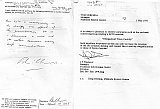 Click for bigger picture..
Click for bigger picture..
|
| Papers/Talks |
Papers/Talks
- Spoke
regularly on the Customer Executive courses ("Installation
Review") at Hursley over the years 1971-74
- Spoke
at the BCS Conference on Methods of Assessing Computer
Performance (Guildford 1972)
- Gave
paper at Online International Conference on Computer
Systems Evaluation (London 1973)
-
Internal papers, eg 'Survey of System Performance Levels'
1971; SE Technical Report on 'Generalised Trace Facility'
1973 (see above)
|
|
| GUIDE |
GUIDE User Group
For
some years I acted as the IBM Representative to the UK
Guide OS Working Group (a very vocal organisation at that
time - made meetings quite interesting....). It was quite
fun though. I got to handle a lot of feeedback, organise
major speakers (eg from the US) for their meetings, and
so on.
In June 1973 I attended the European
Guide Conference in Cannes. Just over 1,000 customer personnel
registered (+200 spouses), including 90-odd from UK.
My
expenses estimate allowed approx £10 per night - for Luxe
grade hotel! - and I think I stayed at The Martinez. Interesting
also the airfare would cover the cost of a whole week
there.
I
stepped down from this role when I left the FSC.
|
|
| Other |
Also
- in
1973 I was selected to attend the 1973 DP Recognition
Event, Estoril (near Lisbon). Unlike the SE Symposiums
of the 60s (which were for SEs from all the European
countries), this was an event to recognise the contributions
of all IBM UK field staff -- 863 attended. Lots of chartered
aircraft! There was some segregation - Salesmen wore
red badges, SEs blue, CEs green.
- in
1974 I became M.B.C.S (Member of the British Computer
Society)
-
Simulation - somewhere I got involved in simulation
languages. I can remember running courses in the GPSS
language for the CEGB at one of their education centres
(in the peak district I think)
|
1973 DP Recognition
Event, Estoril
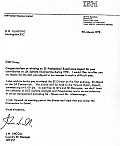 Click for bigger picture..
Click for bigger picture.. |
| |
- In
2H72 was asked to go on assignment to Poughkeepsie as
member of a World Trade team working on MVS. Had to
defer to '73, then cancel, due to illness of my wife.
- Subsequently,
in 1974, the strain of doing a 'Field Job' (where you
had to react to customer situations) combined
with my wife's illness, led to me changing job.
|
|
| UKIS-ASD |
UK IS
In
1974 I transferred to UK Information Systems, IBM UK Head
Office, Cosham as "Information Advisory Analyst" (level
57) in Advanced Systems Development Dept.
|
|
| ASD |
Advanced
Systems
I went
to work for Mike Sanders, who had just joined IS from being
an IBM SE Manager in the City.
- Worked
in areas such as:
- Introduction
Of New Techniques
- preparation
of Strategy for UK IS
- pilot
systems and services
- audits
of major application systems (eg the UK-AAS) and
IS organisation
. Worked
on the UK HQ IS Strategy for 1976-81 (76)
- Major
Studies/Papers
- UK
IS Teleprocessing Service Study (74)
- The
Challenge Of Our Internal Business Communications
(74)
- Microfilm
Study (77)
|
1976 UK-IS Structure
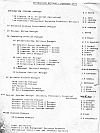 Click for bigger picture..
Click for bigger picture..
.
.
|
| |
Early
'Online Services'
The Cosham
data centre ran the vital administrative and sales applications.
The use of terminals was exploding within IBM. But there
wasn't a service structure to keep these important terminals
'up' or provide the right end-user support.
So one of the early things I got involved in was the
operation of T/P Services.
(the first 'help-desks') |
|
| Early TEXT Systems |
1976-78 Text
Before
this period there was very little processing of text on
commercial data processing systems. Most documents were
typed (by typists and secretaries). There was some use of
formatting languages (eg SCRIPT) by some secretaries and
some professionals to produce bigger documents and presentation
foils. To send a message you wrote it out and passed it
to the Telex Room to key and send.
I
got involved in pilot projects aimed at moving forward
in these areas. This involved producing proposals for
trial text preparation by giving screens to some secretaries
and turning some typists into word-processing girls (using
ATMS - Advanced Text Management Service application).
And, making use of the fact that we now could have collections
of machine-readable documents, we could now also look
at text retrieval services (using STAIRS - STorage And
Information Retrieval System )
So
we ran a trial of these two applications (which took some
organising as they used the CICS transaction environment
- and IBM internal systems were fully committed to the
almost-rival IMS environment.
Also involved in
- Analysis
of the 37EA (pre-announcement of the 3730, 76-77)
- Text
Processing in US Locations (76)
|
1978 article about text project
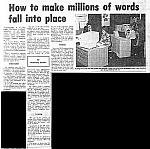 Click for bigger picture..
Click for bigger picture..
|
| North Harbour |
Demonstrated
the ATMS/STAIRS text services to the Duke of Edinburgh on
occasion of the grand opening of North Harbour (3rd Dec
1976).
We also used the newly announced IBM 6640 Ink-Jet Printer
in this demo - ink jets did come in before the mass PC era!
And
at a employee Open Day in Sep 1977 - 5,000 people attended.
|
Carlton Hobbs demo-ing
to the Duke of Edinburgh while I operate things
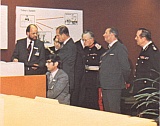 Click for bigger picture..
Click for bigger picture..
Open Day thanks  Click for bigger picture..
Click for bigger picture..
|
| Towards the Paperless Office |
Office Systems
The
CREATION Project:
Capture Retrieval
Editing And Transmission
of Information ON-line
Dec
1975
|
|
| The first 'Office Systems' |
Profs
Pss Email and also shared calendars
Office
Systems in IBM USA (study visit jointly with European
Office Systems staff, Uithoorn, 1/79)
Led
to proposals for comprehensive introduction of Office
Systems throughout IBM UK. What was to become known as
NOSS - National Office Systems Services.
Note
- Internal use of Profs was to explode - by 1989 across
IBM there were to be 350,000 users.....
|
|
| |
Education
- Organisational
Development, Dale Loveluck Assoc (London 7/76)
- IBM
Text Systems (Uithoorn 4/77)
- Online
Conference - Word Processing (London 10/77)
- Infotech
Conference - Future Systems (London 3/77)
- Infotech
Conferences - The Office of the Future, Convergence
(Paris 10/78)
|
|
| InfoCentres |
PERIOD 1978-79.
Definition
And Founding Of Systems UK Information Centre
- Worked
on the definition (roles, responsibilities, reporting)
of an UK "Information Centre"
- Became
IC founder-member in the role of End-User Services Planner
- Analysed
user requirements, specified service offerings, and
assisted in their implementation
- Major
Studies/Papers
-
- Implications
of "Viewdata" for IBM (3/78)
|
|
| |
PERIOD 1979-80
- Joined
IBM UK HQ IS Technical Strategy Dept
- Worked
on the evaluation of new products and techniques
- Department
later merged with Systems Architecture Dept
- Additional
work in review of complex systems requirements and systems
design
- Requirements
& Design Of Large Application Systems
|
|
| |
Major
Studies/Papers
- Convergence
(5/80)
- DDP
- Philosophy, Dangers, 4300 v 8100, Implications
- Efficient
Methods of Information Transfer (machine to people,
1/80)
- The
value of Colour screens
|
|
 Click for bigger picture..
Click for bigger picture..
 Click for bigger picture..
Click for bigger picture.. 
